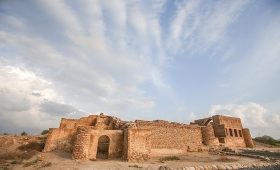Laft Village: A Historical Gem in Hormozgan
Laft Village is one of the most historically significant and picturesque destinations in Hormozgan province, located on the Qeshm Island. Known for its traditional houses, historical monuments, and stunning views, Laft offers a unique glimpse into the region’s past and culture. The village is renowned for its architectural heritage, including ancient windmills and the Naderi Castle, making it a must-visit spot for history and culture enthusiasts.
How to Reach Laft Village
Laft Village is situated in the southern part of Qeshm Island, which can be accessed via boat or ferry from the mainland of Hormozgan. The village is located about 80 kilometers from Bandar Abbas, the provincial capital of Hormozgan. Once you arrive at Qeshm Island, you can travel to Laft by car or taxi, following the well-maintained roads leading to this peaceful village.
Exploring the Traditional Houses of Laft
One of the first things that visitors notice upon arriving in Laft is the village’s unique traditional architecture. The houses in Laft are built using local materials, primarily mud bricks, making them blend harmoniously with the natural landscape. These homes have been designed to withstand the intense heat and humidity of the region, with thick walls, flat roofs, and small windows to keep the interiors cool.
The houses in Laft are also built around a central courtyard, a common feature in traditional Iranian architecture, which provides shade and privacy. The wooden doors and decorative windows give the village a distinct charm, and walking through its narrow alleys feels like stepping back in time. The village is an excellent place to experience the local lifestyle and immerse yourself in the culture of Qeshm Island.
Historical Landmarks in Laft Village
Naderi Castle: One of the most notable historical landmarks in Laft Village is the Naderi Castle, which dates back to the Safavid period. This castle was built to serve as a military defense structure to protect the village and its surroundings from invaders. The castle features impressive stone walls, defensive towers, and strategic positions that offer panoramic views of the village and the surrounding coastline.
The Naderi Castle was named after Nader Shah, one of Iran’s most famous rulers, whose reign extended across much of the region. Today, the castle stands as a symbol of the village’s rich history and serves as a reminder of the military importance of Laft in the past. Visitors can explore the castle’s various rooms, towers, and walls, taking in the historical significance and architectural features of this remarkable structure.
Windmills of Laft: Another striking feature of Laft Village is its traditional windmills, which were historically used to grind grain and harness the power of the wind to provide a sustainable source of energy for the local population. These tower-like structures are an iconic part of Laft’s heritage, and they add a unique beauty to the village landscape.
The windmills in Laft are built with mud bricks and have tall cylindrical towers, which catch the wind to turn large wooden blades. These windmills have been used for centuries and are a testament to the ingenuity of the people of Laft, who have adapted to their environment using traditional and eco-friendly techniques.
The windmills of Laft are not only functional but also serve as an architectural attraction, blending seamlessly with the natural surroundings and offering fantastic photo opportunities for visitors. They are a reminder of the agricultural history of the region and the resourcefulness of the island’s residents.
Cultural Significance of Laft Village
Laft Village is not only a place of historical importance but also a hub of local culture. The village is home to a community that continues to maintain its traditional way of life, and visitors can observe the local customs and craftsmanship that have been passed down through generations.
The village is known for its handicrafts, including woven mats, baskets, and handmade textiles, which visitors can purchase as souvenirs. The people of Laft are also famous for their hospitality, and tourists are often welcomed with open arms, making the experience of visiting the village even more enjoyable.
The village’s cultural significance extends to its traditional music and dance, which are an integral part of the community’s festivals and celebrations. The music, played on traditional instruments such as the oud and tar, adds to the village’s charm and offers a glimpse into the island’s rich artistic heritage.
Best Time to Visit Laft Village
The best time to visit Laft Village is during the fall and winter months, when the weather is cooler and more comfortable for exploring. The spring is also a pleasant time to visit, as the temperatures are mild, and the island’s natural beauty is in full bloom.
Summer can be extremely hot in Hormozgan, with temperatures often exceeding 40°C (104°F), making it less suitable for outdoor activities. Therefore, it’s recommended to plan your visit to Laft Village during the cooler months to make the most of your trip.
Conclusion
Laft Village is a hidden gem in Hormozgan, offering a perfect blend of historical significance, natural beauty, and traditional culture. Whether you’re interested in exploring ancient structures like the Naderi Castle and windmills or simply enjoying the tranquil atmosphere of the village, Laft provides a unique and unforgettable experience. A visit to Laft is not only a journey through history but also an opportunity to connect with the local culture and heritage of Qeshm Island.

